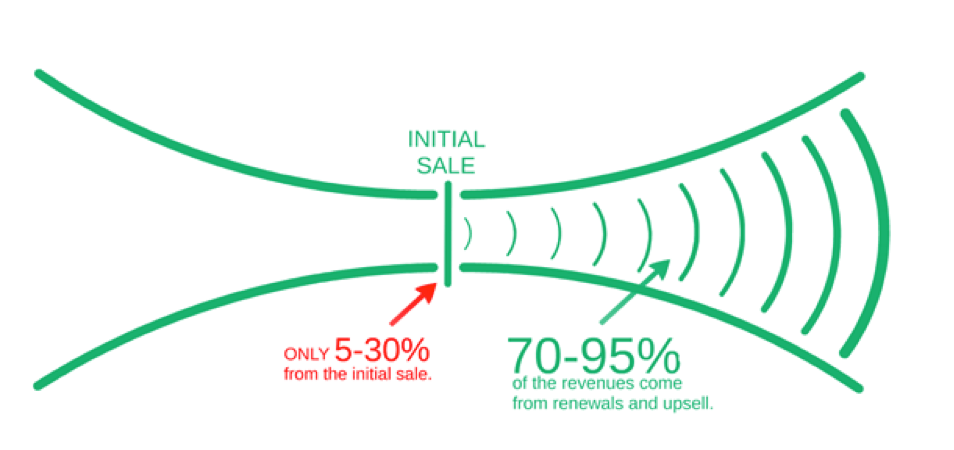How to Stop Selling and Start Serving

When it comes time for a customer to renew their account with your SaaS business, how are they going to make their decision? Will they judge you on the newest pitch from the smooth talking salesmen? Or will they weigh their past experience with your company and the value they have already realized?
Naturally, they are going to use what they know. If they spent a year with your company and loved your service, they’re likely to renew their account.
However,
Are sales teams necessary? Absolutely. You need people to pitch the product/service and bring in new accounts, but sales shouldn’t be your only focus since sales teams do not focus on customer loyalty. Loyalty and value, after all, are what create renewals and expansions.
So once the sale is made, we have to stop selling and start serving.
Hand the account off
Salespeople are great at selling, but not at serving. The two roles require a completely different set of skills. If you want your company to be successful, it’s important to recognize the strengths of your team members and put them in the proper roles.
Once the account is signed, your Customer Success team should become the point of contact. Customer Success managers are built to serve. They are givers who know how to put the customers’ needs ahead of the company’s. They have unique qualities that help them excel at this role.
Find the customer’s pain points
If every interaction the customer has with your business is sales-orientated, they’ll put themselves on guard every time they communicate with you. The relationship will become adversarial. Over time, they’ll grow tired of these exchanges and either stop communicating with you or start communicating with someone else. Neither scenario leads to a renewal.
Instead of pitching and selling, spend more time listening. Ask questions and listen for words that indicate their problems. Pay attention for phrases like…
- “If only I could…”
- “That’s great, but it wouldn’t work.”
- “Maybe, but…”
- “The problem with that is…”
Even if the customer doesn’t use phrases like these, listen for their challenges. Every customer wants to sell more products, reduce their costs, scale their business and (this sometimes is the most important) make their lives less stressful.
Don’t be afraid to research the customer in other ways, as well. Use LinkedIn to see what they are talking about. Speak to some people within the company other than your usual contact. Contact someone you know in a different company that sells a similar product or works in a similar industry. You need as much knowledge as possible to solve the most problems.
The best piece of advice I can give is to talk less. Salesmen have to talk so they can pitch the product. Customer Success managers should ask open-ended questions and listen.
Figure out what success looks like
Every customer is different. They have different needs and goals. If you want to help them find value with your product, you have to know what value means to them. They might say they are focusing on gaining new customers, developing a team, or creating new products. Once you know what they consider success, you can help them work towards it.
You should never assume. If you assume incorrectly, you could spend a lot of time working only to disappoint the customer, even if you did a great job. Even if you help them achieve something amazing, it’s irrelevant if the customer doesn’t find that achievement valuable.
There’s no secret formula here. You just have to ask. Try some of these phrases.
- “So what are you guys hoping for out of our relationship?”
- “What are the company’s goals and what are your goals?”
- “Next year, I want you say, ‘We’re so glad we’re working with XYZ Company.’ How do I get you to say that?”
- “What do you consider success?” (Straightforward language is always good!)
Provide as much value as possible
Over time, your careful listening will help you learn about the customer. Study their challenges and constraints. Use these pain points to provide as much value to the customer as you can. Lincoln Murphy refers to the realization of value as “engagement.”
Providing value can mean a lot of things, depending on your type of customer. It could be as simple as sending them a few links to information they would like, making them aware of changes in their industry, or putting them in touch with someone else who could help. Or it could be as complex as creating a process for their team or coding a custom solution.
In many cases, providing value means helping the customer use your product. Lack of usage is the biggest cause of churn, according to Bluenose.

Oftentimes, being valuable means having solutions ready before the customer needs them. You’ll identify common problems as you work with more customers in the same sector. If you hear the same challenge twice, document the solution you offered so you can reference it again. Your template solution may require a bit of customization for each customer, but you’ll have something concrete ready to deploy at a moment’s notice.
You’ll also want thorough documentation about your product or service available for customers to access any time. Don’t make them call you to get an answer to a basic question.
Good documentation is an evolving tool. Start with onboarding processes so the customer starts gaining value with your product right away. Then begin creating articles that answer common questions and walk the customer through each feature.
Become someone the customer can trust
You have to get over the mentality that the sale is everything. Sometimes selling an additional service to the customer is the wrong decision because it affects the relationship. Don’t be afraid to say “no.”
For instance, if a customer wants to upgrade to your premium plan, but you know the additional benefits don’t apply to this customer, you have to convince them not to expand. If they upgrade and don’t see the value of the new service, you lose credibility as a value-provider. You’ve become just another salesmen they have to work around.
Maintaining the relationship is paramount. Prioritize long-term gains over the short-term ones. This may require setting goals that won’t be realized for a while. Although, don’t forget to sprinkle some short-term value regularly throughout your relationship so the customer doesn’t feel neglected.
Be transparent with the customer. Speak in plain language so they don’t have to decipher your messages. If the customer trusts you as an ally, they’ll buy forever.
Prioritize your current customers
Once your company has landed a new customer, the traditional approach is to hunt for another. But, in the SaaS world, your job isn’t finished after the sign up.
Renewals are just as important as new sign ups. In many cases, they are more important. They stabilize your cash flow and even help you secure funding. Retained users will provide more revenue over time.

Source: KISSmetrics
Just because you’re in the “serving mode” doesn’t mean salespeople should be out of the loop. You have to create a cooperative system where sales and Customer Success teams work together. Use Customer Success to provide value so the customer can’t say, “no” to the sales team.
